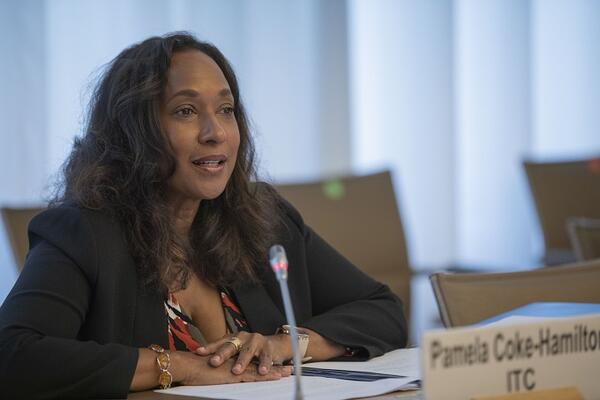
Presentation of the SDG Trade Monitor at the World Trade Organization on World Statistics Day (en)
Good morning colleagues.
The SDG Trade Monitor is an issue that is very close to my heart. Just a few weeks ago, I was leading on this initiative at UNCTAD. Today, in my role as Executive Director at ITC, I remain firmly behind this tool because if we don’t monitor, we don’t deliver.
We all know the reality. We have ten years before we reach the milestone of 2030. The pandemic has thrown us all off track, and the progress that we had collectively made in reaching some of the SDGs has been arrested. We need to put our heads together, pool our expertise and reassess how we will ensure we honour the world’s development compass: the Sustainable Development Goals.
We all agree that trade is one of the most crucial means of implementing the SDGs. Everything from productive capacity to market access to the cross-border movement of food and medical goods and services is recognized and reflected in the targets established by the 2030 Agenda.
Statistics matter. Data matters. Intelligence matters. For micro, small and medium enterprises (MSMEs) − ITC’s core constituency − data and intelligence is what keeps them afloat. It is what helps them understand what to produce, when to produce it, and where to sell it. It is at the core of any business model.
And we know that the health of an economy’s MSME segment reflects the overall health of a country’s economy, with MSMEs representing above 90% of all enterprises and over 60% of employment opportunities. By empowering MSMEs to connect to regional and global supply chains, ITC’s work helps developing countries achieve greater productivity, diversifying both their export baskets of goods and services, and the markets in which they trade.
ITC is also keen to see increased value addition in the products and services exported by developing countries, especially the Least Developed Countries (LDCs). And here we know that progress has not been what we would have liked it to be on boosting LDC’s share in international trade. My ask today − to all of the agencies in the room − is to regroup and see how we, as the trade cluster in the UN system, can harness lessons learned and create a clearer pathway to getting closer to meeting this target by 2030.
The motto for today’s World Statistics Day is “Connecting the world with data we can trust.” Connecting and trust. This means data is meaningless in isolation and without context: it must go to those who most need it, and it must be real, reliable, and representative.
ITC was created and built on the need for trade intelligence services for LDCs and developing countries. That was one of its main functions when ITC was established, here in this same building, in 1964. Today, we are known for our suite of free online market analysis tools that companies around the world can use to discover promising trade and investment opportunities. Today, almost a million registered users of these global public goods have access to information about trade restrictiveness, tariff and non-tariff measures, and sustainability standards.
This is why, today, we celebrate together with our UNCTAD and WTO colleagues the launch of the SDG Trade Monitor.
Through our cooperation, we aim to:
1. Connect the world with international trade data we can trust.
2. Continue to build on joint initiatives, such as the annual World Tariff Profiles report and the Global Trade Helpdesk, to ensure that the Geneva trade hub provides concrete evidence and analysis for developing countries and their MSMEs.
Over the past 15 years, the three agencies have been actively involved in monitoring progress against the trade-related targets of the Millennium Development Goals (MDGs). They have already joined forces to develop and maintain an MDG website to track progress on trade. Together, they managed to give more visibility to international trade diversification and SME competitiveness as cross-cutting topics of the 2030 Agenda for Sustainable Development.
The SDG Trade Monitor will help further streamline the statistical coordination process of the three agencies to provide a centralized and interactive one-stop-shop for the SDG trade indicators. Trade policymakers will now be able to conduct customized analyses and regional and country-level data comparisons using complementary measurements. This will help them to gain a more nuanced understanding of the relationship between trade and development in the SDG Agenda.
The Monitor will also provide a knowledge-sharing platform on which we can brainstorm about the measurements we use, and promote the case for ‘Good Trade’ in the development agenda from a statistical standpoint. And the SDG framework provides us room to learn what we can do better in the next ten years to monitor advances and promote better-informed trade policies.
Critical to the success of the SDG Trade Monitor is the goodwill and cooperation of national customs, statistics institutions and regional trade secretariats. They provide most of the data available on the platform for the collective benefit of all.
As a next step, we will organize bilateral presentations of the SDG Trade Monitor to regional UN bodies and other regional organizations. These will allow us to review the website and ensure its use in the annual monitoring effort demanded by the SDG Agenda.
Our shared mission is to accelerate the implementation of the goals. And to have a robust understanding of the data available. Providing member states access to this data is the first critical step.
Thank you



